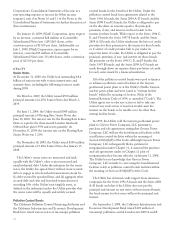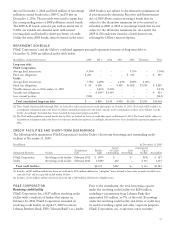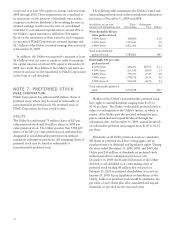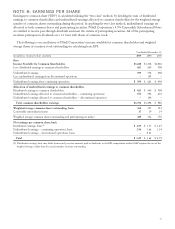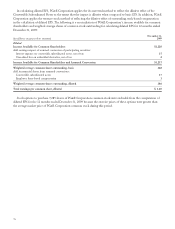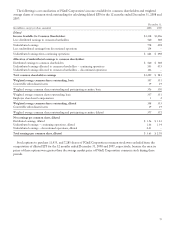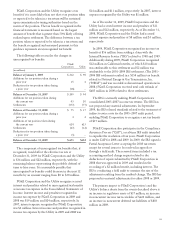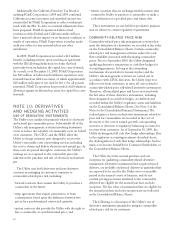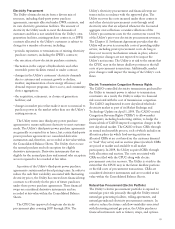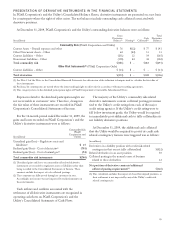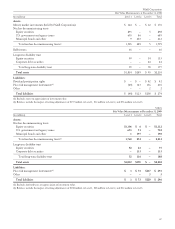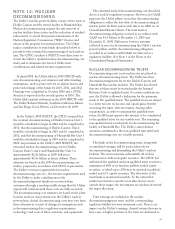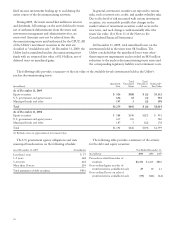PG&E 2009 Annual Report Download - page 86
Download and view the complete annual report
Please find page 86 of the 2009 PG&E annual report below. You can navigate through the pages in the report by either clicking on the pages listed below, or by using the keyword search tool below to find specific information within the annual report.Additionally, the California Franchise Tax Board is
auditing PG&E Corporation’s 2004 and 2005 combined
California income tax returns and amended income tax
returns filed by PG&E Corporation to reflect settlements
made with the IRS. To date, no material adjustments have
been proposed. PG&E Corporation believes final
resolution of the Federal and California audits will not
have a material adverse impact on its financial condition or
results of operations. PG&E Corporation is neither under
audit nor subject to any material risk in any other
jurisdiction.
In 2009, PG&E Corporation recorded a $14 million
benefit, including interest, upon reaching an agreement
with the IRS allowing deductions for items that had
previously been included in the capital loss carry forwards.
As a result, as of December 31, 2009, PG&E Corporation
has $25 million of federal and California capital loss carry
forwards based on filed tax returns, of which approximately
$10 million will expire if not used by 2011. For all periods
presented, PG&E Corporation has provided a full valuation
allowance against its deferred tax assets for capital loss carry
forwards.
NOTE 10: DERIVATIVES
AND HEDGING ACTIVITIES
USE OF DERIVATIVE INSTRUMENTS
The Utility faces market risk primarily related to electricity
and natural gas commodity prices. Substantially all of the
Utility’s risk management activities involving derivatives
occur to reduce the volatility of commodity costs on behalf
of its customers. The CPUC and the FERC allow the
Utility to charge customer rates designed to recover the
Utility’s reasonable costs of providing services, including
the cost to obtain and deliver electricity and natural gas. As
these costs are passed through to customers, the Utility’s
earnings are not exposed to the commodity price risk
inherent in the purchase and sale of electricity and natural
gas.
The Utility uses both derivative and non-derivative
contracts in managing its customers’ exposure to
commodity-related price risk, including:
• forward contracts that commit the Utility to purchase a
commodity in the future;
• swap agreements that require payments to or from
counterparties based upon the difference between two
prices for a predetermined contractual quantity;
• option contracts that provide the Utility with the right to
buy a commodity at a predetermined price; and
• futures contracts that are exchange-traded contracts that
commit the Utility to purchase a commodity or make a
cash settlement at a specified price and future date.
These instruments are not held for speculative purposes
and are subject to certain regulatory requirements.
COMMODITY-RELATED PRICE RISK
Commodity-related price risk management activities that
meet the definition of a derivative are recorded at fair value
on the Consolidated Balance Sheets. Certain commodity-
related price risk management activities reduce the cash
flow variability associated with fluctuating commodity
prices. Prior to September 2009, the Utility designated
qualifying derivative transactions as cash flow hedges for
accounting purposes. As long as the ratemaking
mechanisms discussed above remain in place and the
Utility’s risk management activities are carried out in
accordance with CPUC directives, the Utility expects to
fully recover from customers, in rates, all costs related to
commodity-related price risk-related derivative instruments.
Therefore, all unrealized gains and losses associated with
the fair value of these derivative instruments, including
those designated as cash flow hedges, are deferred and
recorded within the Utility’s regulatory assets and liabilities
on the Consolidated Balance Sheets. (See Note 3 of the
Notes to the Consolidated Financial Statements.) Net
realized gains or losses on derivative instruments related to
price risk for commodities are recorded in the cost of
electricity or the cost of natural gas with corresponding
increases or decreases to regulatory balancing accounts for
recovery from customers. As of September 30, 2009, the
Utility de-designated all cash flow hedge relationships. Due
to the regulatory accounting treatment described above,
the de-designation of cash flow hedge relationships had no
impact on Income Available for Common Shareholders or
the Consolidated Balance Sheets.
The Utility elects the normal purchase and sale
exception for qualifying commodity-related derivative
instruments. Derivative instruments that require physical
delivery, are probable of physical delivery in quantities that
are expected to be used by the Utility over a reasonable
period in the normal course of business, and do not
contain pricing provisions unrelated to the commodity
delivered are eligible for the normal purchase and sale
exception. The fair value of instruments that are eligible for
the normal purchase and sales exception are not reflected
in the Consolidated Balance Sheets.
The following is a discussion of the Utility’s use of
derivative instruments intended to mitigate commodity-
related price risk for its customers.
82


